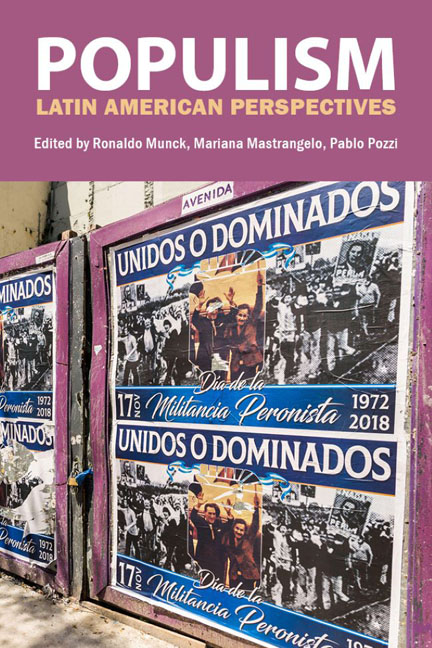Book contents
- Frontmatter
- Contents
- Abbreviations and acronyms
- Foreword
- Introduction
- 1 Populism in Latin America: development, democracy and social transformation
- 2 Peronism in Argentina: left or right?
- 3 The populist left in Chile: socialists and communists from 1936 to 1973
- 4 The left and the Workers’ Party in Brazil: a party between populism, social policies and the popular vote
- 5 Brazil, Bolsonaro and populism of the right
- 6 Political dilemmas of the government of López Obrador: between populism, democracy and the left in Mexico
- 7 The Bolivarian process in Venezuela: socialism, populism or neoliberalism?
- 8 Populist responses to crises of market democracy: the case of Bolivia’s Evo Morales
- 9 Ecuador: populism and the 2007– 17 political cycle
- 10 The Nicaraguan crisis and the mirage of left populism
- 11 Populism and the right in Latin America
- 12 Populism and the left in Latin America
- Afterword: a tale of two “people”: national popular and twenty-first-century Latin American populisms
- Contributors
- Index
12 - Populism and the left in Latin America
Published online by Cambridge University Press: 23 January 2024
- Frontmatter
- Contents
- Abbreviations and acronyms
- Foreword
- Introduction
- 1 Populism in Latin America: development, democracy and social transformation
- 2 Peronism in Argentina: left or right?
- 3 The populist left in Chile: socialists and communists from 1936 to 1973
- 4 The left and the Workers’ Party in Brazil: a party between populism, social policies and the popular vote
- 5 Brazil, Bolsonaro and populism of the right
- 6 Political dilemmas of the government of López Obrador: between populism, democracy and the left in Mexico
- 7 The Bolivarian process in Venezuela: socialism, populism or neoliberalism?
- 8 Populist responses to crises of market democracy: the case of Bolivia’s Evo Morales
- 9 Ecuador: populism and the 2007– 17 political cycle
- 10 The Nicaraguan crisis and the mirage of left populism
- 11 Populism and the right in Latin America
- 12 Populism and the left in Latin America
- Afterword: a tale of two “people”: national popular and twenty-first-century Latin American populisms
- Contributors
- Index
Summary
Are Latin America's populist movements complementary or inimical to the traditional left parties? Or, rather, are they a new type of left, more autochthonous, original and anchored in the subcontinent's realities, as opposed to those ideologies that arose in nineteenth-century Europe? These questions assume, on the one hand, an ahistorical perspective that implies not only a certain uniformity in these movements but also that there are similarities between those movements that arose in the 1930s and 1940s, and those progressive, post-2000, governments that were termed “the pink tide”. On the other hand, there is a problem in defining the term “left”. Are we referring to the many varieties of Marxist groups or do we include anarchists, left nationalists and movements such as the Third World Priests? In addition, the same movements, described by academics as “populist” would not consider themselves to be so. Here we will term “left” all those political movements who question capitalism as a social and economic system and will consider “populist” those movements that tend to consider themselves as a vehicle of the people and its aspirations, implying a progressive slant to their policies, and a challenge to established elites. As such, from a Latin American perspective, people like Brazil's Jair Bolsonaro would not be considered “populist”, while Cuba's Fidel Castro would be placed within the camp of the “left”.
These issues become even more complex if we consider that many of the initial populist movements, in the 1930s and 1940s, joined conservatives, moderates and leftists. At the same time, organizations such as the communist parties considered the new movements as indigenous versions of European fascism, while the populists tended to view the traditional left as competitors, that were extraneous and foreign to Latin American realities. Over half a century later, the pink tide included a large part of the organized left, who considered the reforms by Venezuela's Hugo Chávez or Bolivia's Evo Morales as the way towards a popular revolution. This chapter posits that national and historical circumstances tend to define the relationship between the diverse populist movements and the left.
- Type
- Chapter
- Information
- PopulismLatin American Perspectives, pp. 207 - 220Publisher: Agenda PublishingPrint publication year: 2023



